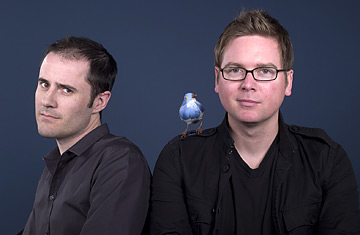
Evan Williams and Biz Stone of Twitter
(3 of 8)
The basic mechanics of Twitter are remarkably simple. Users publish tweets--those 140-character messages--from a computer or mobile device. (The character limit allows tweets to be created and circulated via the SMS platform used by most mobile phones.) As a social network, Twitter revolves around the principle of followers. When you choose to follow another Twitter user, that user's tweets appear in reverse chronological order on your main Twitter page. If you follow 20 people, you'll see a mix of tweets scrolling down the page: breakfast-cereal updates, interesting new links, music recommendations, even musings on the future of education. Some celebrity Twitterers--most famously Ashton Kutcher--have crossed the million-follower mark, effectively giving them a broadcast-size audience. The average Twitter profile seems to be somewhere in the dozens: a collage of friends, colleagues and a handful of celebrities. The mix creates a media experience quite unlike anything that has come before it, strangely intimate and at the same time celebrity-obsessed. You glance at your Twitter feed over that first cup of coffee, and in a few seconds you find out that your nephew got into med school and Shaquille O'Neal just finished a cardio workout in Phoenix.
In the past month, Twitter has added a search box that gives you a real-time view onto the chatter of just about any topic imaginable. You can see conversations people are having about a presidential debate or the American Idol finale or Tiger Woods--or a conference in New York City on education reform. For as long as we've had the Internet in our homes, critics have bemoaned the demise of shared national experiences, like moon landings and "Who Shot J.R." cliff hangers--the folkloric American living room, all of us signing off in unison with Walter Cronkite, shattered into a million isolation booths. But watch a live mass-media event with Twitter open on your laptop and you'll see that the futurists had it wrong. We still have national events, but now when we have them, we're actually having a genuine, public conversation with a group that extends far beyond our nuclear family and our next-door neighbors. Some of that conversation is juvenile, of course, just as it was in our living room when we heckled Richard Nixon's Checkers speech. But some of it is moving, witty, observant, subversive.
Skeptics might wonder just how much subversion and wit is conveyable via 140-character updates. But in recent months Twitter users have begun to find a route around that limitation by employing Twitter as a pointing device instead of a communications channel: sharing links to longer articles, discussions, posts, videos--anything that lives behind a URL. Websites that once saw their traffic dominated by Google search queries are seeing a growing number of new visitors coming from "passed links" at social networks like Twitter and Facebook. This is what the naysayers fail to understand: it's just as easy to use Twitter to spread the word about a brilliant 10,000-word New Yorker article as it is to spread the word about your Lucky Charms habit.
